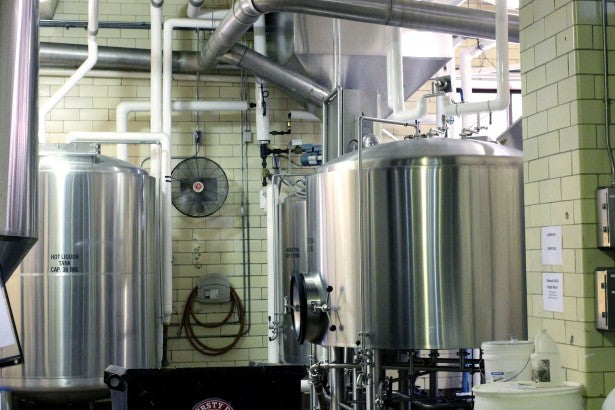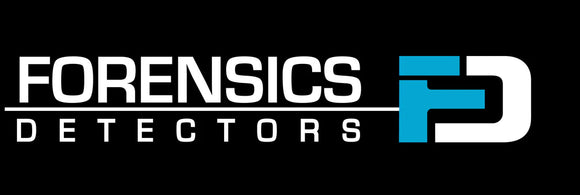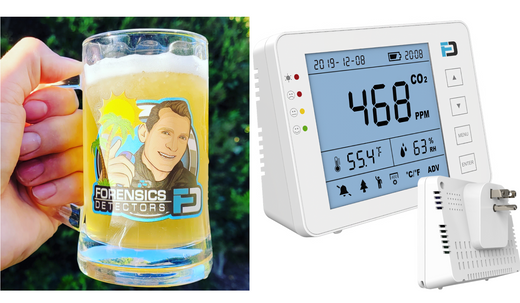CO2 monitors, vital in breweries and beverage industries, safeguard workers by tracking carbon dioxide levels. Essential for safety, they prevent health risks associated with CO2 accumulation, including oxygen depletion, leading to headaches, dizziness, and asphyxiation. These monitors, continuously gauging CO2 concentration, promptly alert workers to unsafe levels. Employing these devices ensures compliance with occupational health regulations and prioritizes employee well-being. Regular monitoring and maintenance guarantee accuracy, enabling swift action to avert harm.
Pros |
Cons |
|
✅ A CO2 monitor save the lives of brewery employees. ✅ Carbon dioxide poses a real threat to brewery employees for both sickness and death. ✅ Brewers can use carbon dioxide monitors to adhere to OSHA regulations. ✅ CO2 monitors has reduced in price |
⛔ The upfront costs associated with some carbon dioxide monitors can be expensive. ⛔ Some brewers may prefer to monitor oxygen alongside carbon dioxide, and not all carbon dioxide monitors offer this feature. ⛔ CO2 often gets confused with CO, two difference gases |
What Are the Best CO2 Monitors for Brewing and the Beverage Industry?
For brewing and the beverage industry, some excellent carbon monoxide detectors include the following:
- Forensics Detectors (Wall Plug-In Monitor)
- Forensics Detectors Analyzer (Personal Monitor)
- Temtop CO2 Professional Monitor
- Extech CO2 Datalogger
- Aranet4 CO2 ppm Handheld

What is CO2 Gas?
CO2, or carbon dioxide, is a molecular compound composed of two parts oxygen and one part carbon. It is essential for biological function of many organisms, however it can also pose a danger to humans in high levels of concentration.
Is CO2 Dangerous?
Exposure to high levels of carbon dioxide can be dangerous. At regular levels, around 400-1,000 ppm, carbon dioxide is perfectly safe. When it gets more concentrated, such as at 5,000 ppm, toxicity and oxygen deprivation have the potential to take place.
What Are Symptoms of CO2 Overexposure?
Inhaling carbon dioxide can have negative effects on the body. Some symptoms of overexposure may include the following:
- Rapid breathing
- Rapid heart rate
- Clumsiness
- Fatigue
- Emotional distress
Over time with continued exposure, more serious symptoms may appear including the following:
- Nausea
- Vomiting
- Collapsing
- Convulsions
- Coma
- Death

Where Does CO2 Gas Rest in the Air?
Carbon dioxide gas naturally rests at ground level. This occurs because carbon dioxide gas is 1.5 times heavier than oxygen, so its sits below the oxygen present in the environment.
What is the Difference Between Food-Grade CO2 and Regular CO2?
The "grade" of CO2 describes the purity of the gas. Such purity is influenced by oxygen concentration, nitrogen concentration, the presence of carbon monoxide, and more. "Regular" CO2 may also be synonymous with industrial-grade CO2 and describes a purity of 99.5% carbon dioxide while food- and beverage-grade CO2 describes a purity of 99.9% carbon dioxide.
Is CO2 a Danger in a Brewery?
Carbon dioxide can become a danger in breweries when it reaches an elevated concentration. It can cause serious symptoms and even death in some cases.
CO2 FUN FACTS
- ✅ A CO2 leak detector is essential for industries such as restaurants, beverage industries, indoor agriculture, and breweries.
- ✅ Carbon dioxide leaks can be deadly even when normal oxygen levels are present.
- ✅ CO2 leak detectors are designed to detect and locate potential CO2 leaks in systems such as commercial refrigeration, soda dispensers, indoor grow facilities, brewery fermentation tanks, and draft beer coolers.
- ✅ CO2 leaks can be caused by failure to service and maintain systems, as well as damage caused through improper or repetitive use.
- ✅ CO2 leak detectors use a non-dispersive infrared sensor (NDIR) to measure carbon dioxide levels and pinpoint potential leak points.
Where Does the CO2 Come From in a Brewery?
Carbon dioxide is produced in several steps of the brewing process.
Carbon Dioxide from Carbonation
The carbonation of soft drinks requires the addition of carbon dioxide to the beverage.
Carbon Dioxide from Fermentation
Adding carbon dioxide to suppress oxygen is a technique to draw out certain flavors in a given beverage over time.
Carbon Dioxide in Pressurization & Rinsing
When adding carbon dioxide to containers used to preserve flavor, internal pressure is created. Such containers also use carbon dioxide during cleaning.
Carbon Dioxide for Inerting
Carbon dioxide can be used to reduce the reaction between fruit juice and oxygen. This is used to prevent further fermentation when the drink has already fermented to satisfaction.
Is Carbon Dioxide Also a Problem for a Winery?
Carbon dioxide is also a problem for wineries. Like breweries, wineries also use fermentation and other similar processes that utilize carbon dioxide to produce their products. As such, they should adhere to similar precautions when it comes to monitoring the concentration of carbon dioxide present.

Is CO2 a Problem When Bottling Beverages and Carbonated Drinks?
Yes, carbon dioxide can become a problem when bottling beverages and carbonated drinks. During this process, carbon dioxide is used to prefill every bottle in anticipation for it to be filled with the beer. As such, there is the potential of overexposure of carbon dioxide, however this can be remedied by monitoring carbon dioxide levels during the bottling process.
How Do Breweries Reduce the Presence of CO2?
When carbon dioxide levels reach excessive concentrations that pose a danger to humans, the first course of action is to evacuate the area. Once everyone has been safely evacuated, workers can seek to reduce the presence of carbon dioxide through two different means: the ring main or manual removal.
Serious Injuries as a Result of CO2 in a Brewery?
Yes, there have been. There have been deaths, even, as a result of carbon dioxide exposure in a brewery. Some examples include the following:
- In 2011, a man was killed while working at a brewery as a result of carbon dioxide overexposure.
- In 2012, two men were killed while working at a brewery as a result of carbon dioxide overexposure.
Are There Laws for CO2 Monitoring in a Brewery?
Yes, there are OSHA requirements that limit the amount of exposure of carbon dioxide that workers and other individuals are allowed to come into contact with at breweries.
What Are the OSHA Requirements for CO2 in a Brewery?
In regards to carbon dioxide overexposure in breweries, OSHA has set exposure limits. For an eight-hour period, the limit is 5,000 ppm, while for a ten-minute period, the limit is 30,000 ppm. Technically, OSHA does not require the use of a carbon dioxide monitor, however it is advisable to use one as this will reduce the chances or violating OSHA's gas exposure limits in addition to better protecting workers.
Do Restaurants Require CO2 Monitoring?
Restaurants require the monitoring of carbon dioxide if they use dispense gas. These safety monitors are required in these situations in order to protect workers and patrons from experiencing dangerous levels of carbon dioxide exposure. In addition to monitoring carbon dioxide, these establishments are also now required to have effective ventilation and an emergency alarm system.

Why Do Breweries Require a CO2 Monitor?
Most breweries require the use of a carbon dioxide monitor, or should require the use of a carbon dioxide monitor, to protect employees from potential overexposure of carbon dioxide. Employees can experience unsafe levels of carbon dioxide in a number of daily functions at the brewery. Such functions may include: cleaning the tanks used for fermentation, accessing walk-in coolers, and working with yeast disposal among other tasks.
Is CO2 Heavier or Lighter Than Air?
CO2 is about 1.5 times heavier than air. That means any CO2 that is released has the propensity to stay low to the ground.
Where Should a CO2 Monitor Be Placed in a Brewery?
- Ideally, employees working within breweries should have access to a portable carbon dioxide monitor at all times so that they can safely check their exposure regardless of where they are.
- Carbon dioxide monitors should be placed around any area that has the potential to have an increased concentration of carbon dioxide. Of particular concern are areas and tanks used for fermentation.
- CO2 monitors should NOT be placed high on the wall, however, should be placed lower than normal, to detect any CO2 accumulation as early as possible.
How Can CO2 Monitors Benefit Brewers?
Carbon dioxide monitors can benefit brewers in two main ways.
For one, using a carbon dioxide monitor has the potential to save lives. No brewer wants to experience the tragedy that is losing an employee to carbon dioxide overexposure. Unfortunately, this has happened in the past, but using a carbon dioxide monitor may prevent this from happening in the future.
The use of carbon dioxide monitors also serves to protect brewers from potential OSHA violations and other regulatory violations, depending on the geographical location of operation. Brewers who are not abiding by OSHA's regulations may find themselves in legal trouble that is costly and time-consuming.
How Much CO2 Does a Brewery Use?
The amount of carbon dioxide that a brewery uses varies by its size. Larger breweries will use and emit more carbon dioxide than a smaller brewery. For instance, a brewery with a size of around 130,000 square feet will emit 250 grams of CO2 per six-pack produced.
Carbon Dioxide Monitor Cost?
Carbon dioxide monitors have a wide range of cost. For instance, of the five that were highlighted earlier, the Forensics Detectors Plug-In Monitor is on the lower cost side about at $95.00 while the PK Safety Monitor is on the higher side with a cost of $920.00.
Is CO2 and CO gas the same?
CO2 is Carbon Dioxide and CO is Carbon Monoxide. They are both different gases used for different purposes with different toxicity levels. Never confuse these two gases although their chemical symbols and names are similar.

How Often Should I Test or Calibrate My CO2 Leak Detector?
The Industrial Safety Equipment Association (ISEA) suggests checking the functional ability of CO2 leak detectors before daily use, and conducting additional testing as needed. It is recommended to perform daily bump testing and calibrate the detectors every 6 to 12 months. By consistently calibrating and maintaining your CO2 leak detector, you can significantly lower the chances of inaccurate readings and promote a safer environment. It's important to adhere to the manufacturer's instructions and advice to optimize the performance and lifespan of your CO2 leak detector.
Can You Smell CO2 In Breweries And Beverage Facilities?
No, carbon dioxide (CO2) is odorless and colorless. For safety in breweries and beverage facilities, CO2 detectors must be used to monitor levels.
Final Words
Carbon dioxide (CO2) is a colorless and potentially deadly gas that poses a significant risk to brewery employees. To minimize the danger of CO2 overexposure, brewers and their staff should implement appropriate safety measures, such as using carbon dioxide monitors to continuously measure CO2 levels in the work environment. These monitors are essential for detecting elevated concentrations of carbon dioxide, which can cause various health issues, including dizziness, headaches, and even asphyxiation in extreme cases. Ideally, each employee should be equipped with a portable CO2 monitor; however, if this is not feasible, it is crucial to place the monitors in easily visible locations throughout the brewery to ensure that workers can quickly check the CO2 levels and take necessary precautions to maintain a safe working environment.
About The Author
Dr. Kos Galatsis ("Dr.Koz") is the President of FORENSICS DETECTORS, where the company operates from the scenic Palos Verdes Peninsula in Los Angeles, California. He is a subject matter expert on gas sensor technology, gas detectors, gas meters, and gas analyzers. He has been designing, building, manufacturing and testing toxic gas detection systems for over 20 years.

Every day is a blessing for Dr. Koz. He loves to help customers solve their unique problems. Dr. Koz also loves spending time with his wife and his three children going to the beach, grilling burgers, and enjoying the outdoors.
Read more about Forensics Detectors here.
Email: drkoz@forensicsdetectors.com
Phone: +1 424-341-3886

